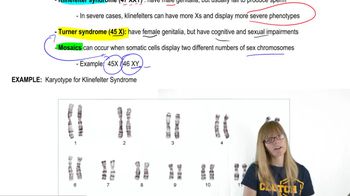Table of contents
- 1. Introduction to Genetics51m
- 2. Mendel's Laws of Inheritance3h 37m
- 3. Extensions to Mendelian Inheritance2h 41m
- 4. Genetic Mapping and Linkage2h 28m
- 5. Genetics of Bacteria and Viruses1h 21m
- 6. Chromosomal Variation1h 48m
- 7. DNA and Chromosome Structure56m
- 8. DNA Replication1h 10m
- 9. Mitosis and Meiosis1h 34m
- 10. Transcription1h 0m
- 11. Translation58m
- 12. Gene Regulation in Prokaryotes1h 19m
- 13. Gene Regulation in Eukaryotes44m
- 14. Genetic Control of Development44m
- 15. Genomes and Genomics1h 50m
- 16. Transposable Elements47m
- 17. Mutation, Repair, and Recombination1h 6m
- 18. Molecular Genetic Tools19m
- 19. Cancer Genetics29m
- 20. Quantitative Genetics1h 26m
- 21. Population Genetics50m
- 22. Evolutionary Genetics29m
3. Extensions to Mendelian Inheritance
Sex Chromosome
Problem 11a
Textbook Question
Consider the case where a mutation occurs that disrupts translation in a single human mitochondrion found in the oocyte participating in fertilization. What is the likely impact of this mutation on the offspring arising from this oocyte?
 Verified step by step guidance
Verified step by step guidance1
<span>Understand that mitochondria have their own DNA, which is separate from nuclear DNA, and they are inherited maternally, meaning they come from the oocyte.</span>
<span>Recognize that a mutation in mitochondrial DNA can affect the function of mitochondria, which are responsible for producing energy in the cell through the process of oxidative phosphorylation.</span>
<span>Consider that if the mutation disrupts translation, it could impair the mitochondrion's ability to produce proteins necessary for its function, potentially leading to a dysfunctional mitochondrion.</span>
<span>Since the mutation occurs in a single mitochondrion, assess the impact by considering the concept of heteroplasmy, where multiple mitochondria with both normal and mutated DNA coexist in a cell.</span>
<span>Evaluate the potential impact on the offspring by considering the proportion of mutated mitochondria and whether it reaches a threshold that could lead to mitochondrial disease or dysfunction.</span>
Recommended similar problem, with video answer:
 Verified Solution
Verified SolutionThis video solution was recommended by our tutors as helpful for the problem above
Video duration:
1mPlay a video:
Was this helpful?
Key Concepts
Here are the essential concepts you must grasp in order to answer the question correctly.
Mitochondrial Inheritance
Mitochondrial inheritance refers to the transmission of genetic material found in mitochondria, which is passed exclusively from mother to offspring. Since mitochondria are inherited through the oocyte, any mutations in mitochondrial DNA can affect all offspring, leading to potential mitochondrial diseases or dysfunctions in energy production.
Recommended video:
Guided course

Organelle Inheritance
Translation Process
Translation is the process by which ribosomes synthesize proteins based on the sequence of messenger RNA (mRNA). Disruption in translation can lead to the production of nonfunctional or absent proteins, which are crucial for cellular functions, particularly in energy metabolism within mitochondria.
Recommended video:
Guided course

mRNA Processing
Impact of Mutations on Offspring
Mutations can have varying impacts on offspring, depending on their nature and location. In this case, a mutation disrupting translation in mitochondria could lead to reduced ATP production, affecting cellular energy levels and potentially resulting in developmental issues or metabolic disorders in the offspring.
Recommended video:
Guided course

Point Mutations

 4:24m
4:24mWatch next
Master Sex Determination with a bite sized video explanation from Kylia Goodner
Start learningRelated Videos
Related Practice



